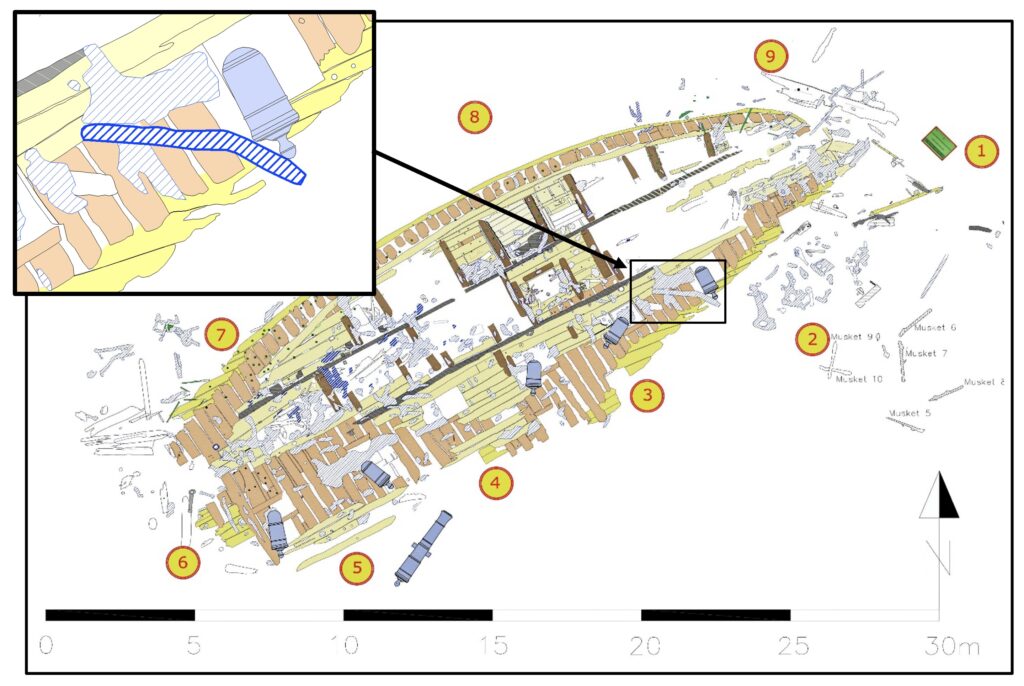One of the least understood elements of the wreck of Colossus is the numerous pieces of heavily concreted iron lying over the surviving timber. Some of the iron is easy to identify, such as ring bolts, clench bolts and similar fastenings. But most has defied identification, one notable example being a large, solid piece of iron lying on the seabed close to Gun 1. It appears on the site plan but has not been examined in detail as it has never been properly de-weeded (a time-consuming process). One of our tasks this year was to identify this particular piece of iron and its function, by clearing the marine growth. We little imagined just how informative this would be.

The mobile kelp was first removed from around Gun 1 and then the fine ‘seaweed’ was carefully detached from the surface of the iron. It became immediately apparent that this object closely resembled the broken and twisted shank of an angle-crown anchor with the arms and crown broken off. Close examination revealed ‘fibrous’ strands of iron under the concretion indicating that it is made of wrought iron.
The iron consists of a bar 2.35 metres long, square sectioned at its southern end (0.17 x 0.17m) and roughly circular in section for the rest of the bar (0.14m ⌀ average). It is slightly bent and appears to be twisted as well. This is a substantial piece of iron and considerable force would have been needed to bend it. We initially speculated that the anchor had become fast on the seabed and the shank was bent and broken when attempting recovery of the anchor.



The anchor shank appears to conform to the typical Admiralty angle-crown type of the late 18th century, so is of the right period and type to be part of the ground tackle on board Colossus. But the dimensions are far too small for it to be one of the ship’s bower anchors. 74-gun ships at this time usually carried six anchors, four main bower anchors (71 cwt, 18ft 6” long),[1] a stream anchor (17cwt, 12ft 6”) and a kedge anchor (8cwt, 9ft 6”). The diameter of the ‘small’ [2] accords well with the published dimensions of a stream anchor for a 74-gun ship such as Colossus.[3] The bower anchors were kept at the bow ready to be dropped and were used for mooring the ship; the stream and kedge anchors were used for manoeuvring in confined waters and were often deployed remotely from one of the ship’s boats. But why is there a broken stream anchor onboard at all?
On site, we speculated that the anchor had broken on recovery from the seabed after becoming stuck. However, a search of the documentary evidence revealed an entry from the logbook of the Master, David Wallace, from 12thFebruary 1797 which records a collision with HMS Culloden on the eve of the battle of Cape St Vincent:
‘At the signal to tack, past the Culloden, wore, the Orion hove in stays. Put our helm up to pass to leeward of the Orion. Hail-d the Culloden to keep her wind she came aboard of us which broke the Shank of the Stream anchor – carried away fore top gallant mast and stove in some of the upper works abreast the 5 gun on the main deck’.[4]
The stream anchor was usually stowed lashed to the outside of the sheet or spare bower anchors, which were carried just to the rear of the two ‘ready to go’ bower anchors. Thus, the stream anchor would probably have been the first thing Culloden made contact with during the collision. The ‘5 gun on the main deck’ was on the port side, third port back from the bow – the guns were numbered starting at the bow: even numbers on the starboard, odd numbers on the port.
Colossus had not been back in home waters since this collision. It seems probable, therefore, that this mystery piece of iron, now thought to be the broken shank from the stream anchor, was the same one broken in that collision with Culloden at the battle of Cape St Vincent. The other half of this anchor may lie somewhere amongst the corroding iron scattered around the site, or on the seabed off Cape St Vincent. The broken anchor part (or parts) was probably stored in the aft hold for transport back to England, and fell from there to its current location while Colossus was on her beam ends and breaking up.
Much ado has been made by various authors of the fact that Colossus had given one of her anchors away to Nelson’s ship Vanguard in Naples and was therefore short an anchor when she was wrecked. It now seems likely that Colossus may have been short not one but two of her six anchors when she foundered in 1798.

[1] Colossus only had 3 bower anchors when she sank as one had been given to Nelson’s ship, Vanguard in Naples
[2] The small is the section of the shank next to the square of the anchor at the ring / stock end of the shank
[3] Arming & Fitting of English Ships of War, Brian Lavery, 1987 p 32
[4] Master’s Log HMS Colossus – ADM 52 2808